[ad_1]
Pros: Smooth, powerful and relatively efficient engine; comfortable ride; adult-friendly third row; advanced driver assistance tech
Cons: Lower-quality interior than rival SUVs, especially the upper trim levels
When it comes to the 2023 Ford Expedition, its greatest asset rests under the hood. Available in three power outputs, all of which outperform nearly every comparable competitor, Ford’s EcoBoost turbo V6 is buttery smooth and surprisingly quiet for a truck engine. It also returns fuel economy that’ll likely save you hundreds or more every year at the pump – money that can be well spent towards the adventures and toys that can be enjoyed along with such a big, capable family hauler. The Expedition also provides competitive interior space (meaning enormous), solid infotainment and safety tech options and characterful trim level options in the King Ranch and Timberline (pictured above).
Of course, the full-size SUV segment has never been more competitive considering how good GM’s various entries have become with the introduction of the Jeep Wagoneer (we’d mention the new Toyota Sequoia but it completely misses the mark). That makes the Expedition’s job that much harder in attracting attention, especially with an interior that’s just not as appealing visually or in quality as its main rivals. It’s no longer a carbon copy of the F-150 cabin, which is nice, but it’s hard not to think Ford couldn’t have gone further as Chevy, GMC, Jeep and even Toyota did. That said, it’s the one main demerit in a big family SUV that is otherwise very strong.
Interior & Technology | Passenger & Cargo Space | Performance & Fuel Economy
What it’s like to drive | Pricing & Trim Levels | Crash Ratings & Safety Features
What’s new for 2023?
After substantial changes were made last year, including the introduction of the new Timberline pictured above, the Expedition carries over into 2023 unchanged apart from wheel design availability and a new red paint color.
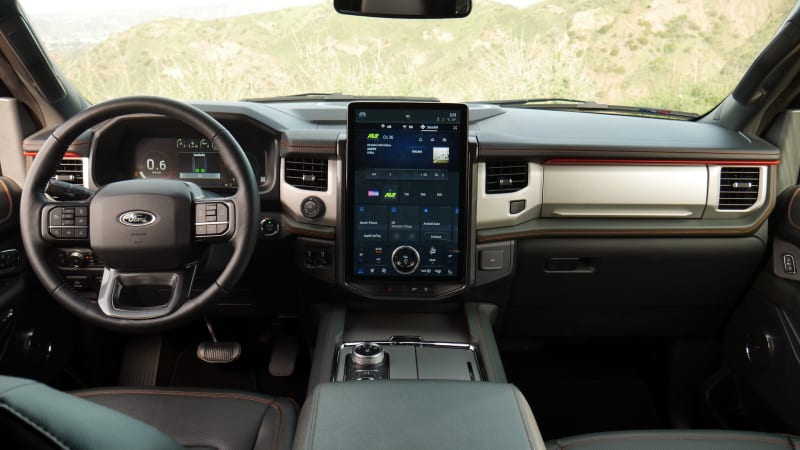
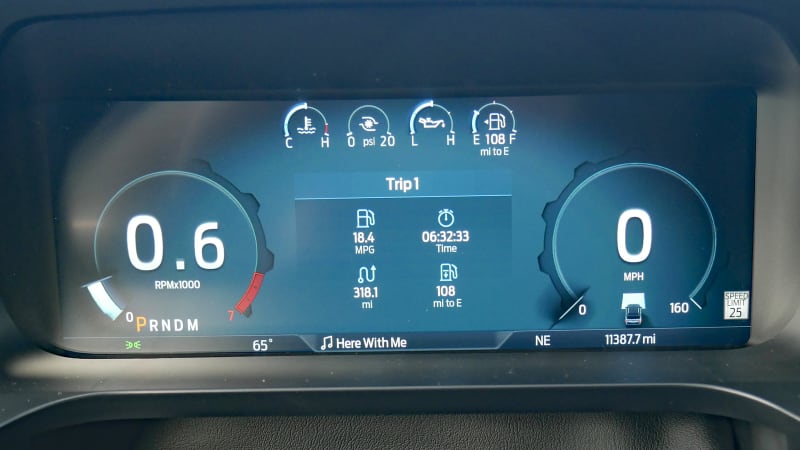
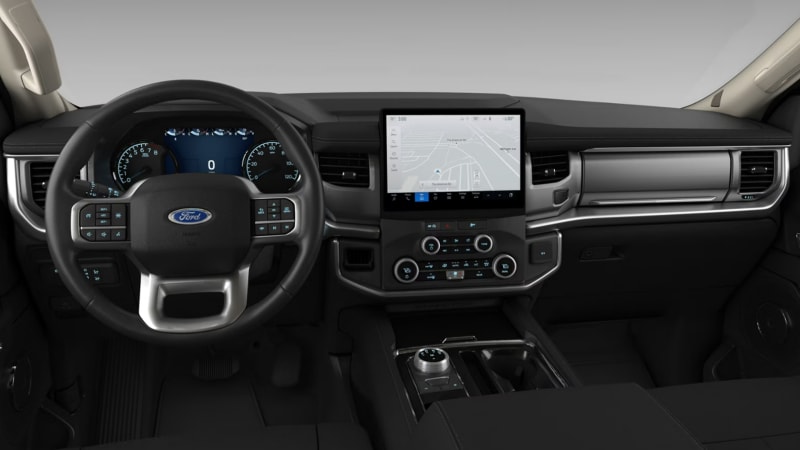
What are the Expedition interior and in-car technology like?
After last year’s updates, the Expedition doesn’t share the dash design of the F-150 for the first time in its lengthy history. Sure, it’s mostly shared with the F-150 Lightning, but we’ll ignore that technicality. This change was largely necessitated by the availability of the 15.5-inch portrait-oriented touchscreen (pictured above, top) also found in the Lightning and Mustang Mach-E. It functions quite different from the standard system: the still pretty big 12-inch touchscreen shared with upper trim level F-150s, the Bronco and others. It is pictured above, bottom right. Though different, we find both easy to use, but certainly wouldn’t hesitate to check the box for the bigger screen. Lower trim levels get a large color instrument panel display bordered by analog gauges, while a full 12.4-inch all-digital display is available on Timberline upward (pictured above, bottom left).
Unfortunately, while the Expedition interior is now less trucky in appearance, its materials quality isn’t as strong as its GM and Jeep competitors. The design also seems a bit low rent compared to what you’ll see in those rivals, especially with the small touchscreen base design. The Jeep Wagoneer in particular puts it to shame, and upper Expedition trim levels in particular just don’t provide a sufficiently high-lux vibe. If you are considering a King Ranch or Platinum, it would definitely make sense to check out the mechanically related Lincoln Navigator instead.
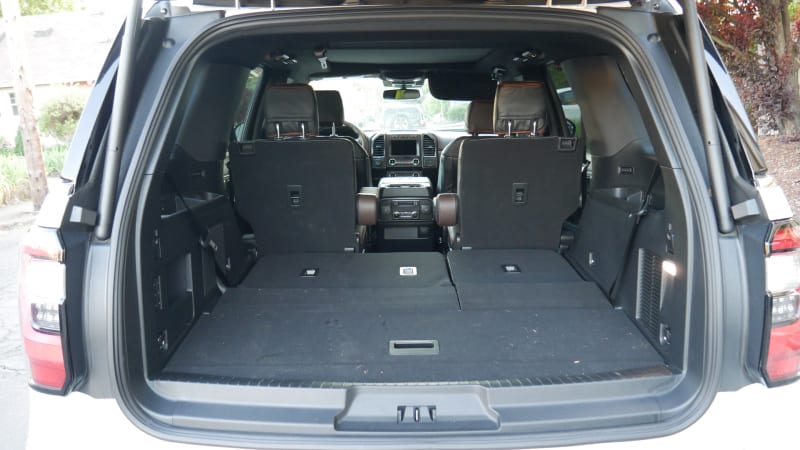
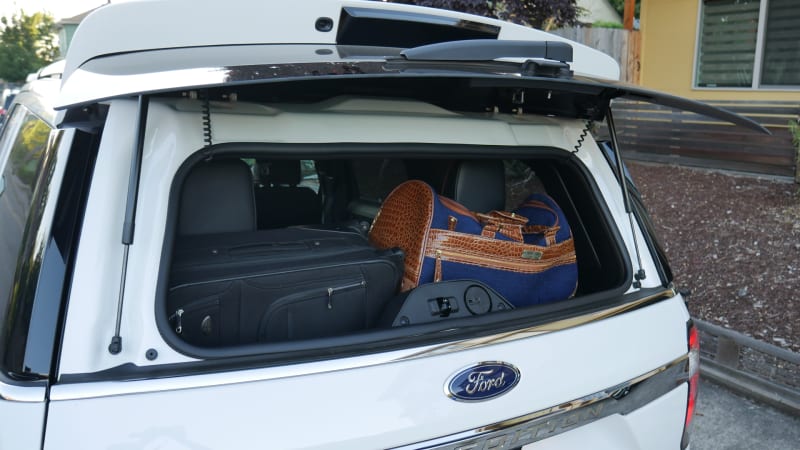
How big is the Expedition?
As with its GM and Jeep competitors, the Expedition is available in two lengths: standard and longer Expedition Max. They feature the same size third-row (again, like its competitors), with the Max’s extra length going entirely to the cargo area. The standard Expedition is 210 inches long, which is essentially the same as the Tahoe/Yukon. The Wagoneer is 4 inches longer. The Max doesn’t grow quite as much as its rivals, though, as the Suburban is 4 inches longer and the Wagoneer L 5 inches longer than the Max, respectively.
That length comes into play with cargo space behind the third row, but we’re really talking degrees of enormity here. The Max’s extra foot of length yields an extra 16.9 cubic-feet of space, which is more than an entire Honda Accord trunk. We think that extra versatility makes the Max’s price premium well worth it and better justifies the Expedition’s price premium in general over big crossovers and minivans. Of course, if it won’t fit in your garage, it’s all a moot point. Ditto if you have your heart set on the Timberline – it’s regular-length only.
The standard Expedition provides 104.6 cubic-feet of boxy, space-efficient space when both rear rows are lowered, a number essentially between large three-row crossovers and minivans. Its SUV rivals, again, are just a little better. When all seats are in place, the volume obviously shrinks considerably to 19.3 cubic-feet. That’s still better than most three-row crossovers, and we found it was good enough to hold five suitcases. Although the Tahoe/Yukon specs show that it has more space back there, our testing didn’t really back that up. The Wagoneer, on the other hand, is the king of the segment behind the third row.
As for passengers in that third row, only the Wagoneer surpasses the Expedition’s space and comfort. Even then, just barely. Of course, the Expedition has a similarly negligible third-row advantage over the GM SUVs as well. Second-row space is not surprisingly voluminous. Keep in mind, though, that the Expedition is quite high off the ground, so it can be difficult to reach all rows of seats, especially the rearmost one. Graceful exits are rare.
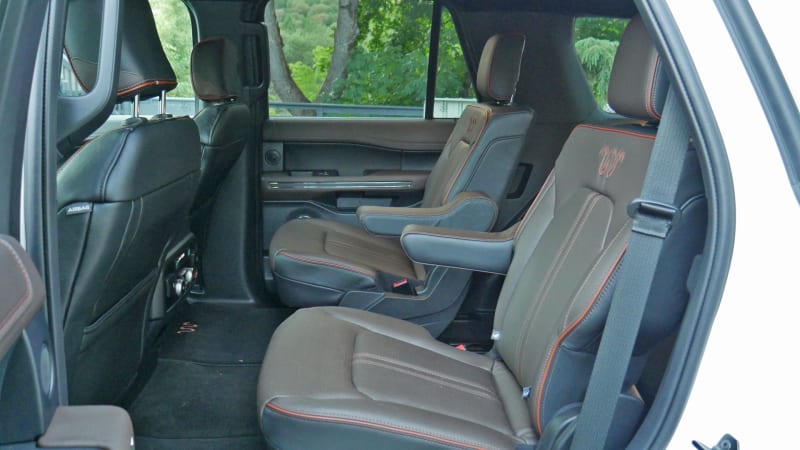
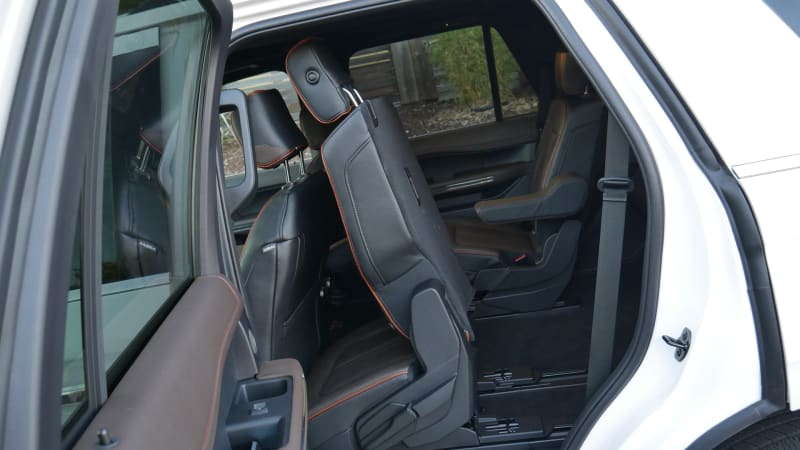
What are the Expedition fuel economy and performance specs?
Every Expedition has a 3.5-liter turbocharged V6, but it is uniquely available with three outputs tied to trim level. All have a 10-speed automatic with rear-wheel-drive standard on all but the Timberline, which comes standard with the four-wheel-drive system offered on all other trims.
The version in the XL, XLT and STX produces 380 horsepower and 470 pound-feet of torque. This is already more than the Tahoe/Yukon’s standard 5.3-liter V8, and more torque than their 6.2-liter V8 option (it’s more torque than the both of the Jeep Wagoneer’s V8s, too). Fuel economy is excellent for a full-size SUV at 17 mpg city, 23 mpg highway and 19 mpg combined with RWD and 16/22/18 with 4WD.
The Limited, King Ranch and Platinum version produce 400 hp and 480 lb-ft of torque. Fuel economy changes negligibly despite this increase, and is therefore much stronger than the upgrade engines of its competitors. It should save you an appreciable amount at the gas pump.
The Expedition Timberline may not be the range-topping trim level, but it nevertheless gets the most powerful version of the 3.5-liter good for 440 hp and 510 lb-ft. Only the Grand Wagoneer L’s new turbo inline-six can top that horsepower (and does so by quite a lot), but Ford maintains its torque lead. Fuel economy goes down, largely due to the Timberline’s all-terrain tires, to 16/19/17. We averaged 18.5 mpg in 380 miles of testing. The Stealth trim also gets this version, but its fuel economy was not known at the time of this writing.
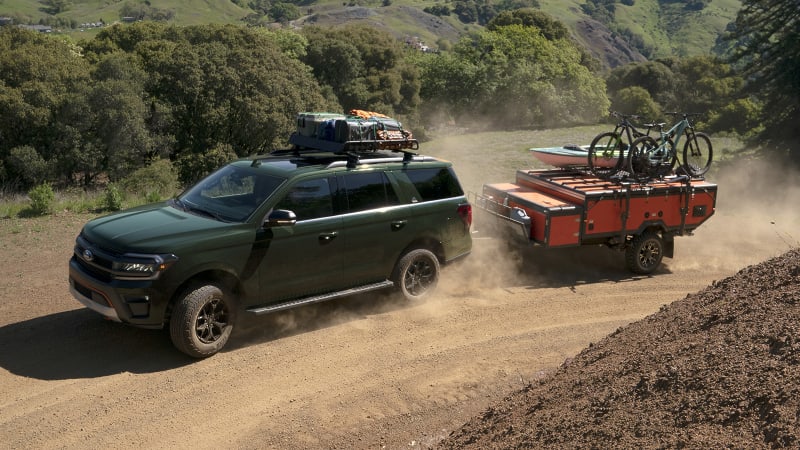
What’s the Expedition like to drive?
The engine is arguably the Expedition’s finest attribute, regardless of which state of tune and trim level you get. The 3.5-liter turbo V6 is buttery smooth and whisper quiet compared to the V8s found in most rivals, and there’s no arguing about its power output. Even the base version gets this big truck moving with authority, while the Timberline and its top-dog 440 hp and 510 lb-ft feels every bit like one of the quickest full-size SUVs on the road. That the fuel economy is generally stronger than most rivals is icing on the cake.
The rest of the Expedition driving experience is impressive as well. It doesn’t feel quite as huge and yacht-like as the Jeep Wagoneers with better body control and seemingly quicker steering. We haven’t had a chance to test an Expedition with the available continuous adaptive dampers, but judging by what they do in the mechanically related Lincoln Navigator, we expect them to increase the Expedition’s comfort and composure even further. Most surprisingly, though, the Timberline doesn’t seem to suffer much for its all-terrain tires and “rough road” suspension tuning. We didn’t detect objectionable tire roar and still found the ride perfectly comfortable.
All of that said, we must of course go with the usual full-size SUV disclaimer that you should not discount the sheer size and weight of the Expedition. It may provide a commanding view of the road and make you feel impregnable, but it’ll also be harder to park and handle worse due to its slower steering, giant dimensions, top-heavy weight and truck platform. That latter element also results in some shivers felt through the structure over certain types of bumps you just wouldn’t get in a large crossover. All of this could also be said of its GM and Jeep competitors. So there, disclaimer provided.
What other Ford Expedition reviews can I read?
2022 Ford Expedition First Drive Review
Highlighting the myriad changes made last year, including the introduction of the Timberline

2020 Ford Expedition King Ranch Road Test
We test the surprisingly tasteful, cowboy chic King Ranch during a road trip. Note that this was written before last year’s updates, so interior impressions in particular no longer apply.
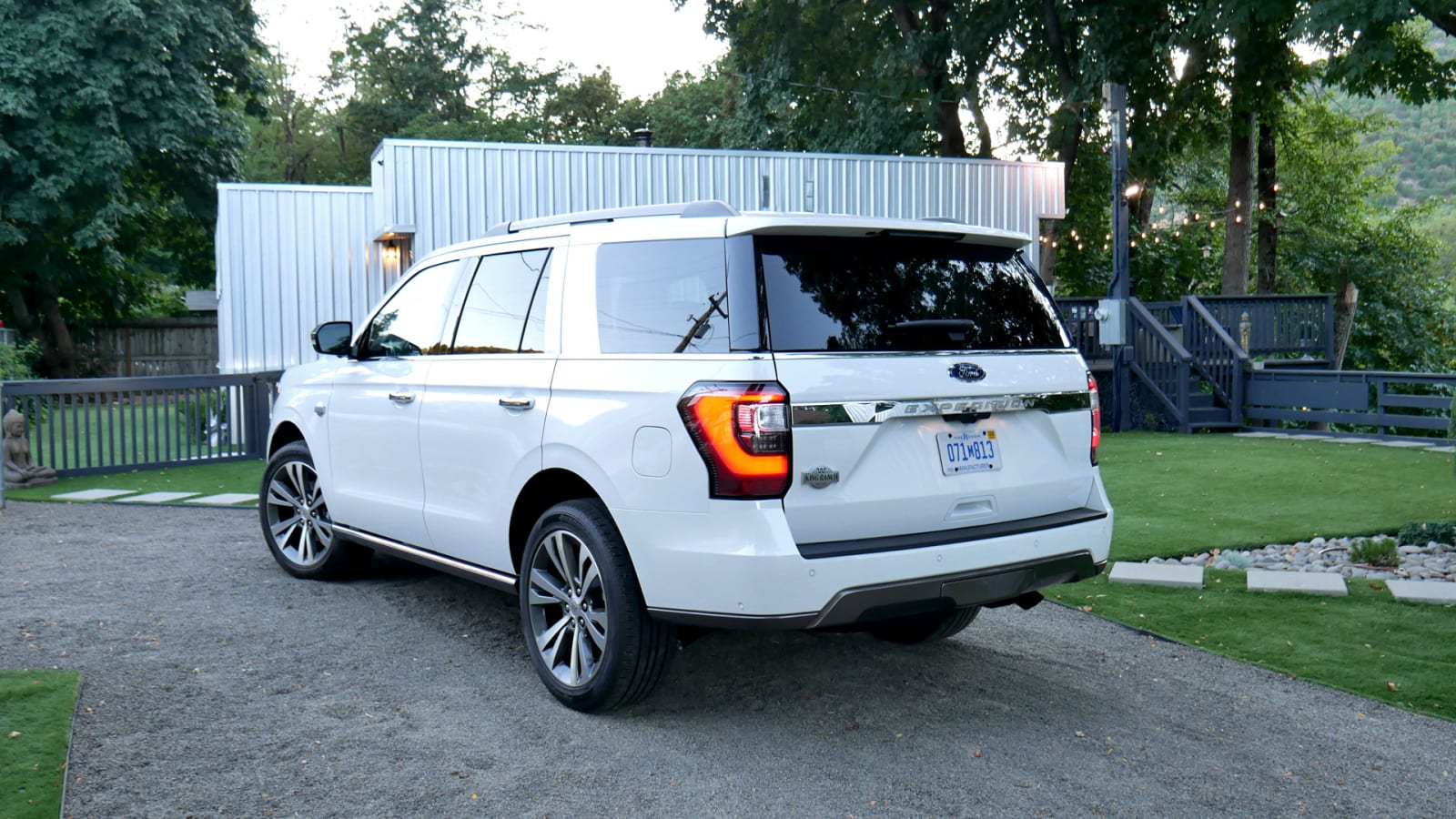
Ford Expedition Luggage Test | How much fits behind its third row?
We use actual stuff to determine how big the Expedition’s cargo capacity is.
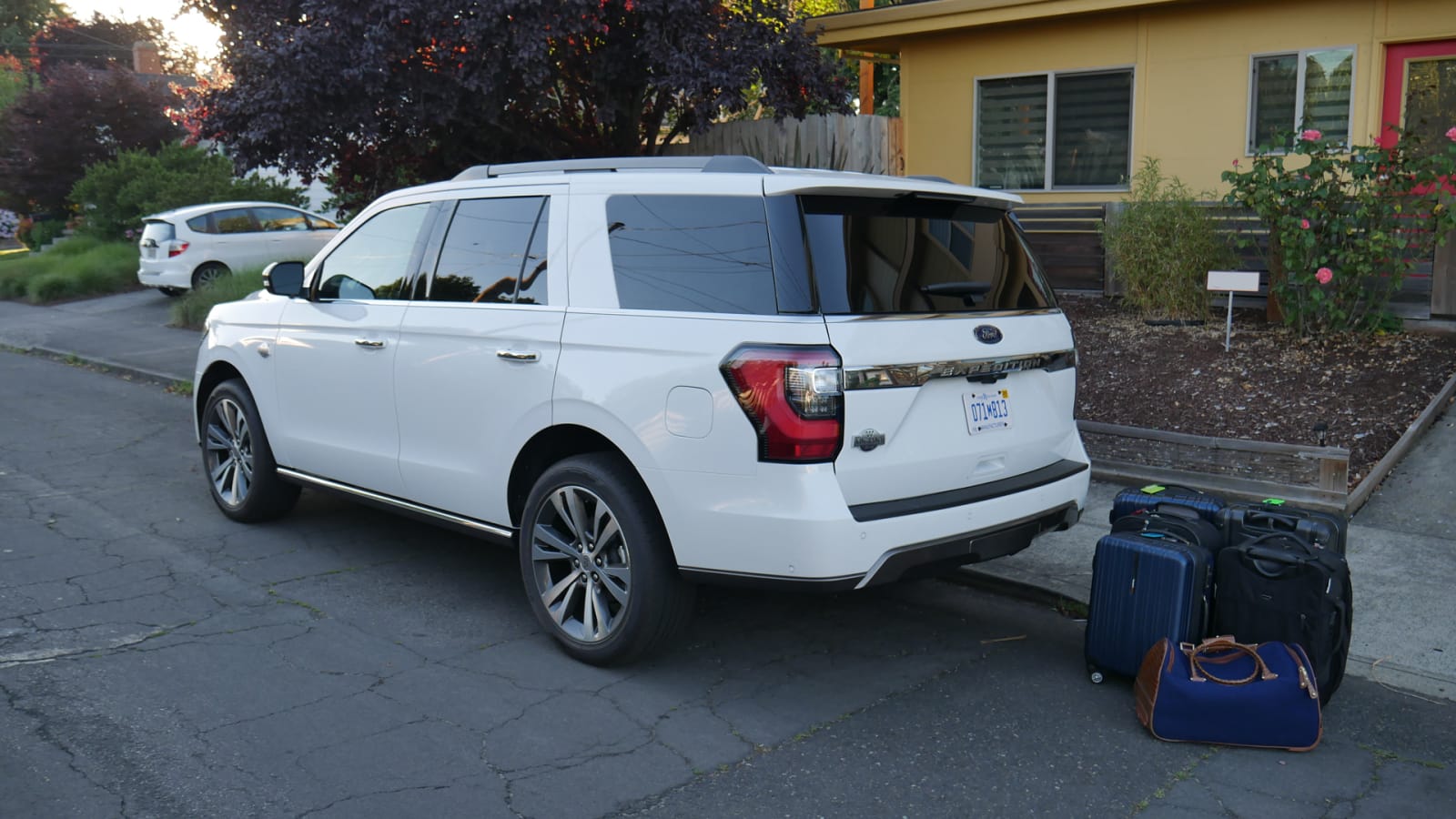
What is the 2023 Expedition price?
Expedition pricing is higher across the board than the Chevy Tahoe’s trim levels, but they don’t always line up in terms of feature content or standard power, so it’s best to do a deeper dive into the specs and features before dismissing the Ford as too expensive.
The XL STX, XLT and Limited feature the typical ladder-like increase of equipment, with the Limited in particular adding popular items like leather, heated front seats and a sunroof. Things then fork in different directions. The King Ranch adds various luxury features at least optional on the Limited, plus unique western-inspired color schemes and badging (the brick red interior has been a King Ranch trademark for years). The Platinum is more comparable to the Luxury in appearance, but maxes out on content. The Timberline is less luxurious to begin with than the Limited, but has standard four-wheel drive, more power, a skid plate, black 18-inch wheels, all-terrain tires, Trail Control off-road drive modes and unique orange highlights everywhere. You can add most of the niceties from the luxury trims.
All prices below include the hefty $1,895 destination charge. Four-wheel drive is $3,050 on all but the Timberline, which has it standard.
XL STX: $75,020
XLT: $61,085
Limited: $69,955
Timberline: $73,295
King Ranch: $80,010
Platinum: $82,460
XLT Max: $63,085
Limited Max: $71,955
King Ranch Max: $82,010
Platinum Max: $84,460
What are the Expedition safety ratings and driver assistance features?
Every 2023 Expedition comes standard with forward collision warning, automatic emergency braking, lane-keeping assist, blind-spot and rear cross-traffic warning systems and automatic high beams. The Co-Pilot360 Assist 2.0 package, optional on the Timberline and standard on those trims above, adds front parking sensors, reverse braking assistance, a 360-degree parking camera system with multiple views and camera washers, and adaptive cruise control with stop-and-go capability and lane-centering steering assist. In testing, we found the latter to perform very well, even on tighter, congested highways and in wet conditions.
The NHTSA gave the Expedition a perfect five stars in every crash category, though it only got a three-star rollover rating (not surprising and consistent for a full-size SUV).
[ad_2]
Source link